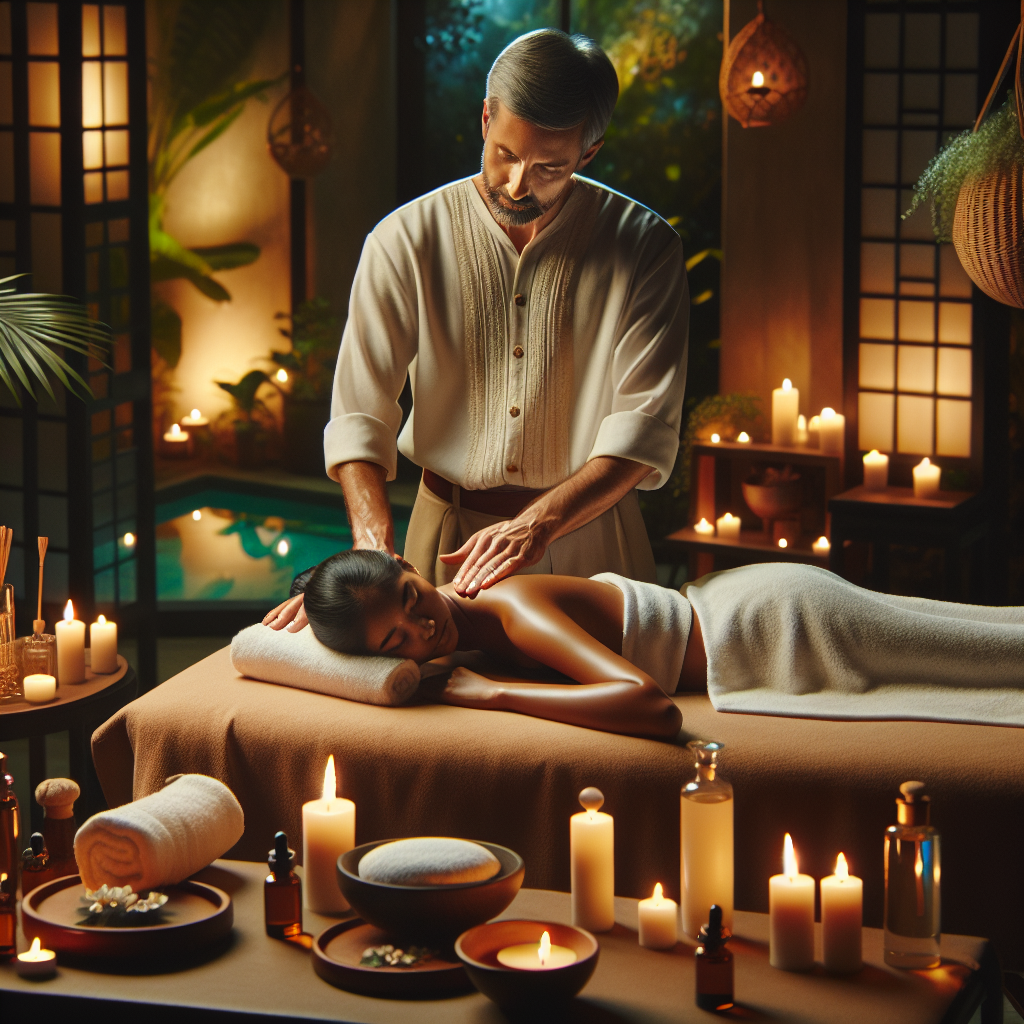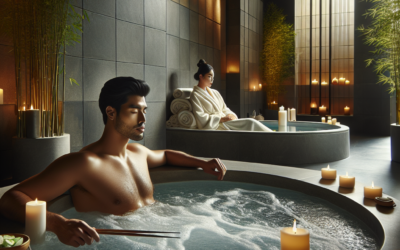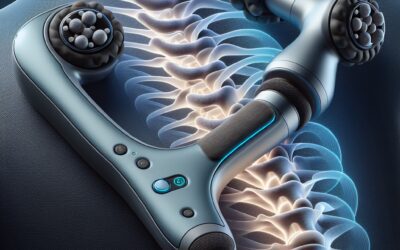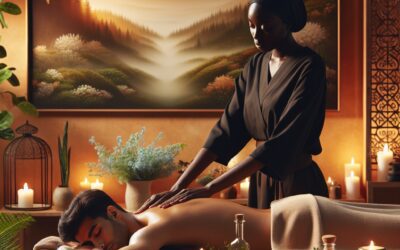Table of Contents
Introduction
Massage is a therapeutic practice that involves the manipulation of the body’s soft tissues, including muscles, connective tissue, tendons, ligaments, and skin. Through a variety of techniques, such as stroking, kneading, tapping, and pressure, massage aims to promote relaxation, alleviate pain, improve blood circulation, reduce stress, enhance well-being, and assist in the rehabilitation of injuries. It is an ancient form of healing with roots in various cultures around the world and is used today in many settings, including spas, clinics, hospitals, and private practices. Massage therapy can be applied to different parts of the body or be focused on specific areas for targeted relief.
The Therapeutic Benefits of Regular Massage
Massage therapy, an ancient practice that has been refined over millennia, is widely recognized for its therapeutic benefits. It involves the manipulation of soft tissues in the body, including muscles, connective tissues, tendons, ligaments, and skin. Regular massage sessions offer a multitude of health benefits that contribute to a person’s overall well-being, making it an essential component of a holistic approach to health care.
One of the primary benefits of regular massage is the reduction of stress and anxiety. In today’s fast-paced world, stress has become a common affliction, with many individuals experiencing chronic stress that can lead to serious health issues. Massage therapy activates the body’s relaxation response, which in turn decreases the production of stress hormones such as cortisol. This hormonal adjustment not only fosters a sense of calm and relaxation during the massage session but can also have lasting effects that contribute to reduced anxiety and improved mood over time.
Moreover, massage therapy is highly effective in managing pain, particularly for those suffering from musculoskeletal disorders. By targeting specific areas of tension and employing techniques such as kneading, tapping, and stroking, massage can alleviate pain by increasing blood flow to affected areas, which aids in the healing process. Additionally, it can help release endorphins, the body’s natural painkillers, providing relief from chronic pain conditions such as arthritis, fibromyalgia, and lower back pain.
The benefits of massage extend to enhancing one’s physical performance and recovery. Athletes, for instance, often incorporate regular massage into their training regimens to prevent injuries and expedite recovery from strenuous workouts. Massage helps to improve flexibility and range of motion by stretching tight muscles and connective tissues, which can prevent muscle strains and sprains. Furthermore, it promotes faster recovery by facilitating the removal of lactic acid and other metabolic wastes from the muscles, reducing soreness and improving muscle function.
Another significant advantage of regular massage is its impact on circulatory health. The pressure applied during massage helps to move blood through congested areas, while the release of this same pressure causes new blood to flow into these tissues. This process not only delivers fresh oxygen and nutrients to the cells but also assists in the removal of waste products, which can help lower blood pressure and improve overall cardiovascular health.
Massage therapy also plays a role in boosting the immune system. Studies have shown that regular massage sessions can increase the activity level of the body’s natural killer cells, which play a crucial role in defending the body against pathogens. By reducing stress and improving circulation, massage contributes to a healthier immune system, making the body more resilient against illnesses.
Lastly, the therapeutic benefits of massage extend to mental and emotional well-being. The nurturing touch of a skilled therapist can provide comfort and a sense of being cared for, which can be particularly beneficial for individuals dealing with emotional distress or mental health issues. The relaxation and stress relief provided by massage can lead to better sleep patterns, more focused attention, and an overall sense of balance and harmony.
In conclusion, the therapeutic benefits of regular massage are manifold, addressing not only physical ailments but also contributing to mental and emotional health. By incorporating massage into one’s routine, individuals can enjoy a more balanced lifestyle, with reduced stress, improved physical function, and a strengthened immune system. As a non-invasive and holistic treatment, massage therapy stands as a testament to the enduring power of human touch as a source of healing and rejuvenation.
Exploring Different Massage Techniques and Their Advantages

Massage therapy is an ancient practice that has evolved over centuries, encompassing a diverse range of techniques each with its own unique benefits. As we delve into the world of massage, it becomes evident that the choice of technique can significantly influence the therapeutic experience and outcomes. This exploration of different massage techniques and their advantages will provide insight into how these practices can promote health and well-being.
One of the most widely recognized forms of massage is Swedish massage, known for its gentle and relaxing approach. This technique utilizes long, flowing strokes, kneading, and circular movements on superficial layers of muscle using massage oil or lotion. The primary advantage of Swedish massage is its ability to induce relaxation, reduce stress, and improve circulation. It is particularly beneficial for those new to massage therapy or individuals seeking a less intense experience.
In contrast, deep tissue massage targets the deeper layers of muscle and connective tissue. The therapist applies slow, deliberate strokes that focus pressure on areas of tension and pain. This technique is especially advantageous for individuals with chronic muscle problems, such as soreness, injury, or imbalance. Deep tissue massage can help break up scar tissue and reduce muscle tension, leading to improved range of motion and reduced pain.
Another popular technique is sports massage, which caters to the needs of athletes and active individuals. This form of massage is designed to prevent and treat injuries, enhance athletic performance, and facilitate recovery. Sports massage incorporates elements of Swedish and deep tissue massage but with a focus on areas of the body that are overused and stressed from repetitive and often aggressive movements. The advantage of sports massage lies in its ability to speed up recovery time, improve flexibility, and prevent future injuries.
Reflexology is a distinct type of massage that applies pressure to specific points on the feet, hands, or ears. These points are believed to correspond to different organs and systems of the body. Reflexology can be particularly beneficial for those seeking relief from stress and tension headaches. It promotes relaxation, improves circulation, and supports the body’s efforts to function optimally.
Shiatsu, a form of Japanese bodywork, involves rhythmic pressure along the body’s energy pathways, known as meridians. The therapist uses fingers, thumbs, and palms to apply pressure, which can stimulate the natural flow of energy (qi) within the body. Shiatsu can be advantageous for those experiencing fatigue, chronic pain, and stress-related conditions. It aims to restore balance in the body and can lead to a sense of increased vitality and well-being.
Hot stone massage is a therapeutic technique where heated stones are placed on specific points on the body. The warmth of the stones helps to relax muscles, allowing the therapist to apply deeper pressure if needed. The heat can also expand blood vessels, which encourages blood flow throughout the body. Hot stone massage is beneficial for those with muscle tension and can also provide relief from stress and anxiety.
Lastly, aromatherapy massage combines the soothing power of touch with the therapeutic benefits of essential oils. Essential oils are selected for their specific healing properties; for example, lavender is often used for its calming effect. When inhaled and absorbed through the skin, these oils can help to alleviate mood swings, reduce stress, and even improve sleep quality.
In conclusion, the variety of massage techniques available offers a wide range of advantages tailored to individual needs and preferences. Whether seeking relaxation, pain relief, or enhanced athletic performance, there is a massage technique that can address these goals. By understanding the different techniques and their benefits, individuals can make informed decisions about which type of massage therapy will best support their health and well-being.
How Massage Can Alleviate Work-Related Stress
In the hustle and bustle of modern work environments, stress has become a common companion for many professionals. The relentless pressure to meet deadlines, manage workload, and balance personal life can take a toll on one’s physical and mental well-being. Amidst this scenario, massage therapy emerges as a beacon of relief, offering a respite from the daily grind and a means to alleviate work-related stress.
Massage, a practice rooted in ancient traditions, has evolved into a scientifically backed method for reducing stress and promoting relaxation. It involves the manipulation of soft tissues in the body, such as muscles, tendons, and ligaments, to improve circulation, ease muscle tension, and enhance overall health. The benefits of massage are not merely confined to the physical realm; they extend to the psychological aspect of stress management as well.
One of the primary ways massage can mitigate work-related stress is through the reduction of cortisol levels in the body. Cortisol, often referred to as the “stress hormone,” is produced in higher quantities during periods of stress, leading to various negative health outcomes such as hypertension and reduced immune function. Massage therapy has been shown to decrease cortisol levels, thereby promoting a sense of calm and reducing the physiological impacts of stress.
Furthermore, massage can stimulate the production of endorphins, the body’s natural painkillers and mood elevators. The release of these neurotransmitters during a massage session can lead to a feeling of euphoria, combatting the emotional drain caused by work-related stress. This mood-lifting effect can help individuals approach their work with a renewed sense of energy and a more positive outlook.
Another significant aspect of massage in stress management is its ability to improve sleep quality. Stress often disrupts sleep patterns, leading to insomnia or restless nights, which can exacerbate the feeling of being overwhelmed and fatigued. By promoting relaxation and reducing muscle tension, massage can facilitate deeper and more restorative sleep, enabling individuals to wake up refreshed and better equipped to handle the challenges of their workday.
Moreover, massage can enhance focus and concentration, which are often compromised under stress. The relaxation response elicited by massage can clear the mind and improve cognitive function, allowing for better decision-making and problem-solving abilities. This mental clarity is invaluable in a work setting where attention to detail and strategic thinking are paramount.
In addition to these physiological and psychological benefits, the very act of taking time out for a massage can be a powerful statement of self-care. It signals a commitment to one’s health and well-being, setting boundaries between work and personal life. This conscious effort to prioritize oneself can help in creating a more balanced lifestyle, where stress is managed proactively rather than reactively.
In conclusion, massage offers a multifaceted approach to combating work-related stress. By lowering cortisol levels, boosting endorphins, improving sleep, and enhancing mental function, it provides a holistic solution to the stressors of the modern workplace. As individuals and employers alike recognize the importance of well-being in productivity and job satisfaction, massage therapy stands out as an effective tool in fostering a healthier, more balanced workforce. Embracing the practice of regular massage can be a transformative step towards managing stress and enhancing overall quality of life.
The Role of Massage in Sports Recovery and Performance
Massage has long been recognized as a therapeutic tool, but its role in sports recovery and performance is a subject that has garnered increasing attention in recent years. Athletes at all levels are turning to massage not only as a means to alleviate post-exercise soreness but also as a strategy to enhance athletic performance. This article explores the multifaceted benefits of massage in the context of sports, shedding light on how it can be a critical component in an athlete’s recovery and performance regimen.
The physical demands of training and competition can lead to the accumulation of stress and tension in an athlete’s muscles. Massage therapy addresses this by promoting relaxation and reducing muscle stiffness, which in turn can help prevent injuries. The manipulation of soft tissues during a massage increases blood flow to the affected areas, delivering oxygen and nutrients while flushing out metabolic waste products such as lactic acid. This improved circulation accelerates the body’s natural recovery process, reducing the duration of muscle soreness and facilitating quicker returns to training.
Moreover, massage can play a pivotal role in injury rehabilitation. By breaking down scar tissue and increasing flexibility, it aids in restoring the range of motion and improving the function of injured muscles. This is particularly important for athletes who need to maintain a high level of performance consistently. Regular massage sessions can help identify potential problem areas before they develop into full-blown injuries, allowing for preemptive measures to be taken.
Beyond the physical benefits, massage also has psychological advantages that can enhance sports performance. It is known to reduce stress and anxiety levels, which is crucial for athletes facing the pressure of competition. The calming effect of massage can lead to better sleep patterns, which is essential for recovery, as the body repairs and strengthens itself during sleep. A well-rested athlete is more likely to perform at their peak, with improved concentration and a lower risk of fatigue-related errors.
The type of massage and the timing of the therapy are important considerations for maximizing its benefits. For instance, a deep tissue massage is often recommended for athletes with chronic muscle tension, while a lighter, more relaxing Swedish massage might be more appropriate for pre-event preparation or post-event recovery. The timing of the massage in relation to exercise is also critical. A pre-event massage might focus on stimulating muscles for optimal performance, whereas a post-event massage would aim to relax and rehabilitate tired muscles.
Incorporating massage into an athlete’s training program requires a tailored approach. Each athlete’s body responds differently to massage, and what works for one may not work for another. It is important for athletes to work with experienced massage therapists who understand the demands of their specific sport and can adjust their techniques accordingly.
In conclusion, massage is an invaluable tool for athletes seeking to enhance their recovery and performance. Its ability to improve circulation, reduce muscle tension, aid in injury rehabilitation, and provide psychological benefits makes it an integral part of modern sports training programs. As research continues to uncover the mechanisms behind massage’s effectiveness, its use in sports is likely to become even more sophisticated and targeted, helping athletes to achieve their full potential.
Massage and Mental Health: Easing Anxiety and Depression
Massage therapy, long revered for its ability to alleviate physical tension, has also emerged as a valuable tool in the battle against mental health challenges, particularly anxiety and depression. The intricate connection between the body and mind underscores the profound impact that physical interventions can have on emotional well-being. As such, massage has been increasingly recognized for its potential to soothe the mind, ease psychological distress, and foster an overall sense of tranquility.
Anxiety, characterized by persistent and excessive worry, can manifest in a variety of physical symptoms, including muscle tension and insomnia. Massage therapy directly addresses these physical manifestations by promoting relaxation and reducing muscle strain. The gentle kneading and stroking motions inherent in massage techniques stimulate the production of endorphins, the body’s natural painkillers and mood elevators. Consequently, this biochemical response can lead to a reduction in the physiological symptoms associated with anxiety, thereby creating a calming effect that permeates both body and mind.
Moreover, the serene environment typically associated with massage therapy—soft lighting, soothing music, and a tranquil setting—contributes to a sensory experience that can help individuals detach from the stressors of daily life. This sensory engagement encourages individuals to focus on the present moment, a practice akin to mindfulness meditation, which has been shown to be beneficial in managing anxiety. By fostering a state of mindfulness, massage can help interrupt the cycle of anxious thoughts that often plague those suffering from anxiety disorders.
Depression, on the other hand, is marked by persistent feelings of sadness and loss of interest in activities once enjoyed. It can lead to a range of emotional and physical problems that can diminish a person’s ability to function at work and at home. Massage therapy can play a role in mitigating some of these challenges by providing a nurturing touch that is often lacking in those with depression. The power of touch should not be underestimated; it can help to convey empathy, acceptance, and support, which are all critical elements in the healing process for those experiencing depressive episodes.
Research has indicated that massage therapy can lead to decreases in cortisol, a stress hormone, and increases in serotonin and dopamine, neurotransmitters that are often out of balance in individuals with depression. By helping to regulate these chemicals, massage can assist in alleviating some of the biological factors that contribute to depression. Additionally, the relaxation and stress relief provided by massage can improve sleep patterns, which are frequently disrupted in those with depression, thus offering another avenue through which massage can support mental health.
It is important to note that while massage therapy can be a valuable component of a comprehensive mental health care plan, it is not a standalone treatment for anxiety or depression. It is most effective when used in conjunction with other therapeutic approaches, such as psychotherapy and medication. Nonetheless, for those seeking a holistic approach to mental health care, massage offers a promising adjunctive therapy.
In conclusion, the intersection of massage and mental health is an area ripe with potential for those struggling with anxiety and depression. By addressing both the physical and emotional aspects of these conditions, massage therapy can provide a multifaceted approach to healing. As our understanding of the mind-body connection deepens, the role of massage in mental health care is likely to expand, offering a gentle, non-invasive means of fostering emotional resilience and well-being.
Integrating Massage into Your Wellness Routine
Integrating Massage into Your Wellness Routine
In the pursuit of holistic well-being, individuals often explore various avenues to enhance their physical and mental health. Among these, massage therapy stands out as a time-honored practice that has transcended cultures and generations, offering a plethora of benefits that extend beyond mere relaxation. As we delve into the integration of massage into one’s wellness routine, it is essential to understand its multifaceted nature and the profound impact it can have on overall health.
The concept of massage as a therapeutic intervention is rooted in the manipulation of soft tissues in the body, including muscles, connective tissues, tendons, ligaments, and skin. By applying different pressures, movements, and techniques, massage can alleviate a wide range of ailments, from the physical to the psychological. It is this versatility that makes massage an invaluable addition to any wellness regimen.
One of the primary advantages of regular massage is its ability to reduce stress and anxiety. In today’s fast-paced world, stress has become a ubiquitous challenge, contributing to a host of chronic health issues. Massage therapy counters this by promoting relaxation and triggering the release of endorphins, the body’s natural feel-good hormones. Consequently, incorporating massage into your routine can lead to improved mood and a more balanced state of mind.
Moreover, massage has been shown to enhance physical health by improving circulation. The kneading and stroking motions during a massage session increase blood flow, which in turn facilitates the delivery of oxygen and nutrients to cells throughout the body. This improved circulation not only aids in the healing of injuries but also supports the immune system, helping the body to fend off illness more effectively.
For those engaged in regular physical activity, massage can be particularly beneficial. It aids in the recovery of sore muscles, reduces muscle tension, and increases flexibility. By incorporating massage into a post-workout routine, athletes and fitness enthusiasts can accelerate their recovery times and prevent the onset of muscle soreness, thereby optimizing their performance.
Additionally, massage therapy has been linked to better sleep patterns. The relaxation induced by a massage session can help to regulate the body’s sleep-wake cycle, leading to deeper and more restorative sleep. This is especially valuable for individuals who suffer from sleep disorders or those who experience difficulty unwinding after a stressful day.
It is also worth noting that massage can play a role in managing chronic pain conditions such as arthritis, fibromyalgia, and lower back pain. By reducing muscle tension and improving joint mobility, massage can offer a non-pharmacological approach to pain management, which can be a welcome alternative or complement to traditional medical treatments.
To effectively integrate massage into your wellness routine, it is important to consider your individual needs and preferences. Some may benefit from weekly sessions, while others may find that a bi-weekly or monthly schedule suffices. It is also crucial to seek out a qualified massage therapist who can tailor their approach to your specific health concerns and wellness goals.
In conclusion, the integration of massage into one’s wellness routine is a practice that offers a wealth of benefits. From stress reduction and improved circulation to enhanced recovery and better sleep, the positive effects of massage are as diverse as they are significant. By making massage a regular part of your self-care regimen, you can take a proactive step towards maintaining and enhancing your overall well-being.
Q&A
1. **What are the benefits of massage?**
Massage can help reduce stress, pain, and muscle tension. It may also improve circulation, energy, and alertness, and can promote better sleep and relaxation.
2. **What are the different types of massage?**
Common types of massage include Swedish, deep tissue, sports, hot stone, reflexology, Thai, shiatsu, and prenatal massage.
3. **How often should someone get a massage?**
The frequency of massage depends on individual needs, goals, and budget. Some may benefit from weekly sessions, while others may find a monthly session sufficient.
4. **What should I expect during my first massage?**
During your first massage, you can expect to fill out a health history form and discuss any areas of concern with your therapist. You will be asked to undress to your comfort level and lie on a massage table, covered by a sheet or towel. The therapist will then perform the massage according to your needs.
5. **Can massage help with injury recovery?**
Yes, massage can aid in injury recovery by reducing inflammation, improving flexibility, and increasing blood flow to the affected area, which can help accelerate the healing process.
6. **Are there any conditions for which massage should be avoided?**
Massage should be avoided or used with caution in certain conditions such as severe osteoporosis, deep vein thrombosis, bleeding disorders, or recent surgery. Always consult with a healthcare provider before getting a massage if you have health concerns.
Conclusion
Conclusion:
Massage therapy is a widely recognized and effective method for reducing stress, pain, and muscle tension. It can also have a variety of other health benefits, including improving circulation, enhancing immune function, promoting sleep, and reducing anxiety. Regular massage sessions can contribute to a better sense of well-being and may aid in the management of various health conditions. However, it is important to consult with a healthcare provider before beginning any new therapy, especially for individuals with certain medical conditions.




0 Comments